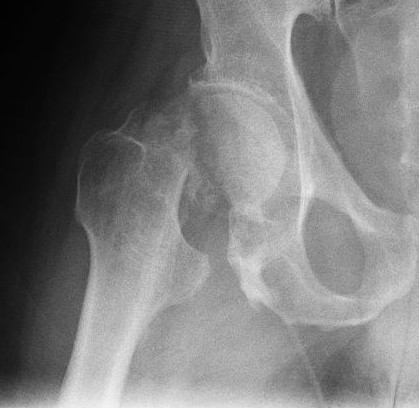
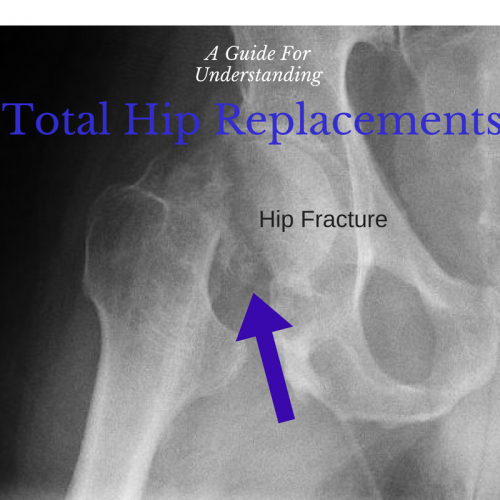 One of the most dreaded diagnoses associated with elderly falls is a subsequent hip fracture. Fractures involving the hip joint and/or the femur (leg bone above the knee) can either require a TOTAL HIP REPLACEMENT (THR)–aka TOTAL HIP ARTHROPLASTY (THA)–or an OPEN REDUCTION INTERNAL FIXATION (ORIF) surgery. Hip fractures requiring total replacement of the hip joint generally require rehabilitation and special precautions. This page will provide general facts/tips, basic Physical Therapy Exercises, and an overview of the precautions associated with a Total Hip Replacement.
One of the most dreaded diagnoses associated with elderly falls is a subsequent hip fracture. Fractures involving the hip joint and/or the femur (leg bone above the knee) can either require a TOTAL HIP REPLACEMENT (THR)–aka TOTAL HIP ARTHROPLASTY (THA)–or an OPEN REDUCTION INTERNAL FIXATION (ORIF) surgery. Hip fractures requiring total replacement of the hip joint generally require rehabilitation and special precautions. This page will provide general facts/tips, basic Physical Therapy Exercises, and an overview of the precautions associated with a Total Hip Replacement.
General Facts & Tips
Falls can be very dangerous and even lethal. Fractures, head trauma, wounds, pressure sores (develop as a result of decreased out of bed activity), skin tears, depression, blood clots, infections, muscle atrophy (weakness), pain, swelling, and inability to resume one’s prior level of function–are some of the potential complications associated with falls and significant injuries.
Hip fractures can be particularly challenging, life-altering and fatal in the elderly population. Elderly patients either rehab well or dramatically decline, fail to thrive, and eventually either give up (pass away) or withdraw into severe depression following a hip fracture and joint replacement surgery.
Did you know, the long bones of the legs (femurs) and the flat bones of the pelvis are where the body manufactures a large portion of its blood supply? In other words, the bones of the hips and upper legs are essentially the body’s blood bank. Therefore, a fracture involving the hip and/or femur can compromise the body’s blood bank resulting in:
- extensive bruising, pain, swelling, and risk for anemia,
- pronounced fatigue/weakness,
- and even the potential need for blood transfusion(s) to replenish the blood supply.
To decrease bruising, I have had good results with my patients drinking pineapple juice. The enzymes apparently help to promote healing and decrease the discoloration of bruises. In addition, it is very important for patients to wear their COMPRESSION HOSE per his/her doctor’s orders. Compression hose control swelling and decrease the risk of developing blood clots. Click HERE to view a video demonstrating how to easily put on compression hose.
Moreover, falling and fracturing a bone/joint–especial in the aging population–results in decreased independence, increased need/use of medical equipment and additional assistance for activities of daily living (showering, dressing, toileting) as well as compromised mobility (walking, transferring, rolling, scooting, and getting in/out of bed) due to an increased fear of another fall.
Recommended Home Medical Equipment
| Total Hip Kit | Elevated Toilet Options | Showering & Bathing |
 |
 |
|
 |
||
 |
**The Bed Side Commode is very VERSATILE. Use it over the existing bathroom toilet by removing the bucket and/or in the shower as a shower chair (clean the BSC while showering your loved one).
Exercises Before and Following a Total Hip Replacement
Lying Down Exercises
Ankle Pumps & Circles
Heel Slides
Short Arc Quads
Gluteal Sets (Buttock Squeezes)
Sitting Exercises
Kicking
Reclined Marches (Knee Raises)
Standing Exercises Both Legs
Heel Raises
Toe Raises
1/4 Squats
Side Stepping
Standing Exercises For the Surgical Leg Only
Knee raises
Forward Kicking with a Straight Leg
Backward kicking with a Straight Leg
Ham curls
Walk, Walk, Walk–The Most Important Exercise
When walking there are some important things to remember
- Make sure the walker has been adjusted appropriately. The hand grip should be at the same height as the bend of the wrist when standing up straight. I also recommend moving the wheels to the INSIDE of the walker to increase the likelihood of the walker clearing narrow doorways. Click HERE for a video demonstrating how to move the rolling walker wheels to the inside of the walker.
- Make sure both feet walk past each other with every step. In other words, decrease limping and short, choppy steps.
- Do NOT plant the surgical foot and pivot when turning! In other words, pick up the surgical foot while turning.
Hip Precaution Overview
Every caregiver of a loved one, patient, and client should know the total hip precautions set forth and prescribed by orthopedic surgeons following a THR. Below is a table of pictures to help describe hip precautions after hip replacement.
Hip Precaution DO’s |
Hip Precaution DO NOT’s |
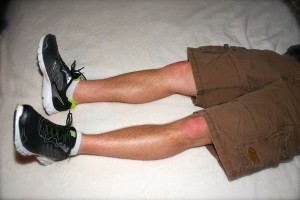 Toes CAN point out to the side |
 DO NOT CROSS THE LEGS
|
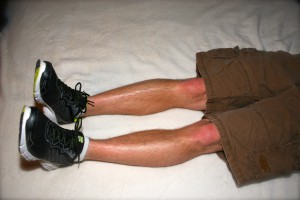 Toes CAN point straight up to the ceiling |
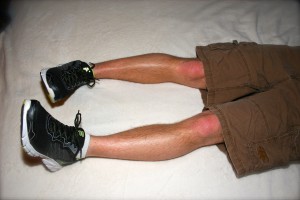 DO NOT let the toes point in toward the other leg |
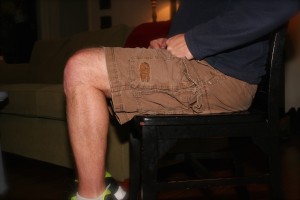 The height of the knees should be the same or LOWER than the hip |
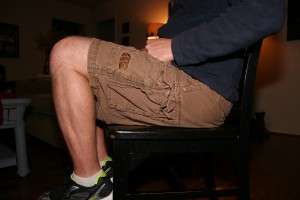 DO NOT sit with the knees HIGHER than the hip |
Related Tips and Helpful Information
Now let’s take the precautions a step further…
After a hip replacement surgery, the hip joint is weak and vulnerable to certain movements and positions. One position of vulnerability is bending at the hip beyond 90 degrees, but what does that mean? Bending over 90 degrees at the hip means either the knees come closer to the shoulders (sitting in a low chair or on a low toilet takes the height of the knees higher than the hips as seen above) or the shoulders come closer to the knees (lying in bed and reaching to the bottom of the bed to pull the comforter up, bending over to tie shoes or put on socks). To avoid bending at the hips, patients should be familiar and use the Total Hip Kit (Pictured Above) that includes: a Reacher/Grabber, a Long-handled shoe horn, a Long-handled sponge, a Sock Aid, a Looped Leg Lifter, and Elastic Shoe Strings.
Another position of vulnerability is crossing the legs. Crossing the legs at any time (lying in bed, sleeping, sitting down, and standing/walking) is a significant violation of the hip precautions after surgery. Be very careful and avoid crossing your surgical leg when you turn around in standing, change directions/turn during walking, and rolling over to get out of bed. To prevent the legs from crossing while sitting and lying down, patients are usually prescribed a knee separator pillow and leg wedge (Abductor wedge) to keep the legs apart (Both are pictured above as well). To avoid crossing the legs while walking and standing, Physical Therapists instruct patients to PICK UP the FEET with every step of turning. Specifically, patients are trained not to PLANT their surgical foot on the ground and turn toward the opposite foot.
The final position of vulnerability occurs during exercises or getting in and out of bed. Keeping the knees 90 degrees away from the shoulders can be difficult when doing certain exercises like MARCHES and LOWER EXTREMITY FLOOR BIKE (PEDDLER) cycling in sitting. Therefore, I have my patients lean back or recline their upper body to do any knee raises (marches) in sitting. I personally DO NOT use a peddler in the home because I focus on functional strengthening through standing and walking versus less challenging exercises such as sitting and peddling the feet. However, I have provided a picture of a floor peddler below because the pedlar is commonly used in several rehab settings.
Finally, I am sure your loved one has been advised not to sleep on his/her surgical hip, but I want to explain why this is important. I constantly inform my patients, “If there are any outward signs of a recent surgery like a healing incision, imagine what the surgical site looks like under the skin.” Healing requires good circulation and oxygen. Sleeping on the surgical side will compress the surgical site and impede (slow down) both circulation and oxygen. Therefore, it is important to avoid sleeping on the surgical hip to promote optimal healing through good circulation of blood and oxygen.
Hip replacement recovery and rehabilitation are very important following a hip fracture. However, if you have any questions or would like additional advice, please leave a comment or question below. I will make the best attempt to answer within 48 hours to make the responsibility of caring for a loved one easier and safer before and after a hip replacement surgery.
Until Next Time Be Safe and Stay Health 🙂

I’m having left total hip replacement, & have been advised to purchase a ‘boat pillow’ for elevation in home chairs. Where do I find them, does anyone have any idea on thickness?
Hi, if you have posterior hip replacement precautions, my patients have been using the AliHip Cushion. My patients order the pillows on Amazon because it was cheaper and can be shipped the next day. You can designate whether you need a Left or Right pillow. Let me know if this helps. Good luck with your surgery and recovery.
Sincerely, Shawna PT, MPT
I am grateful to you for sharing some tips and a guide on how to recover from total hip replacement such as drinking pineapple juice. You said that this would significantly reduce decrease bruising in the affected area of your hip. Plus, it is also important to always wear your compression hose to control the swelling and eliminate the possibility of a blood clot. If I were to undergo rehab from hip surgery, I would make sure to keep this in mind. Thanks.
You’re most welcome. I really have had great success with pineapple juice. Just remember to drink it in moderation- you don’t want to irritate your mouth.
Thanks for these! My dad might have to get his hip replaced, and he asked me to help him prep for that if it did need to happen. I figured he would want to be back up and going before long, so I think some of these more simple exercises will be better. i will make sure that he keeps his knee to 90% when he does so!
My pleasure. Keep it simple, take your time, and always allow enough time for full recovery- don’t rush the healing process! God bless y’all and I pray for a rapid recovery